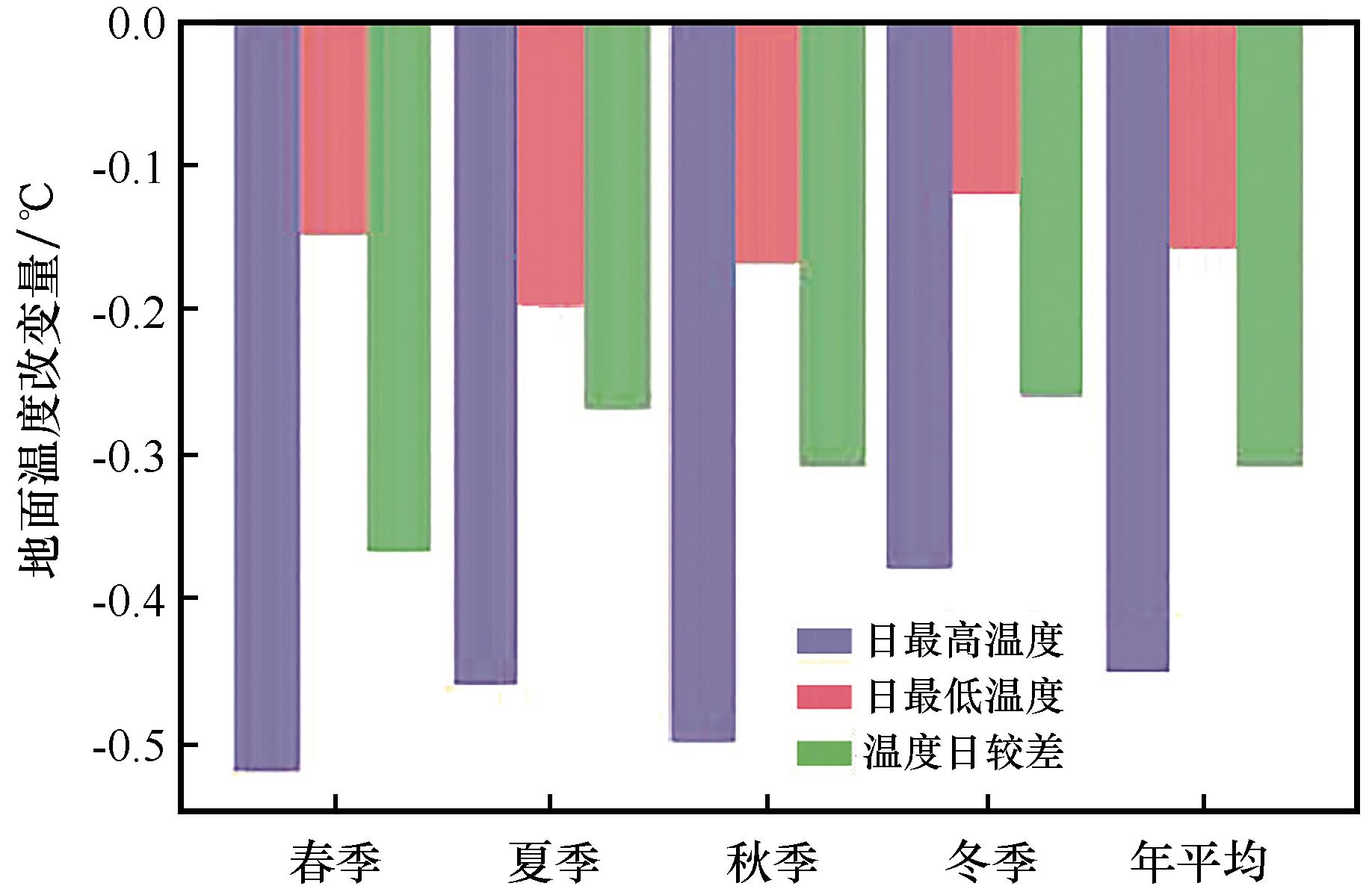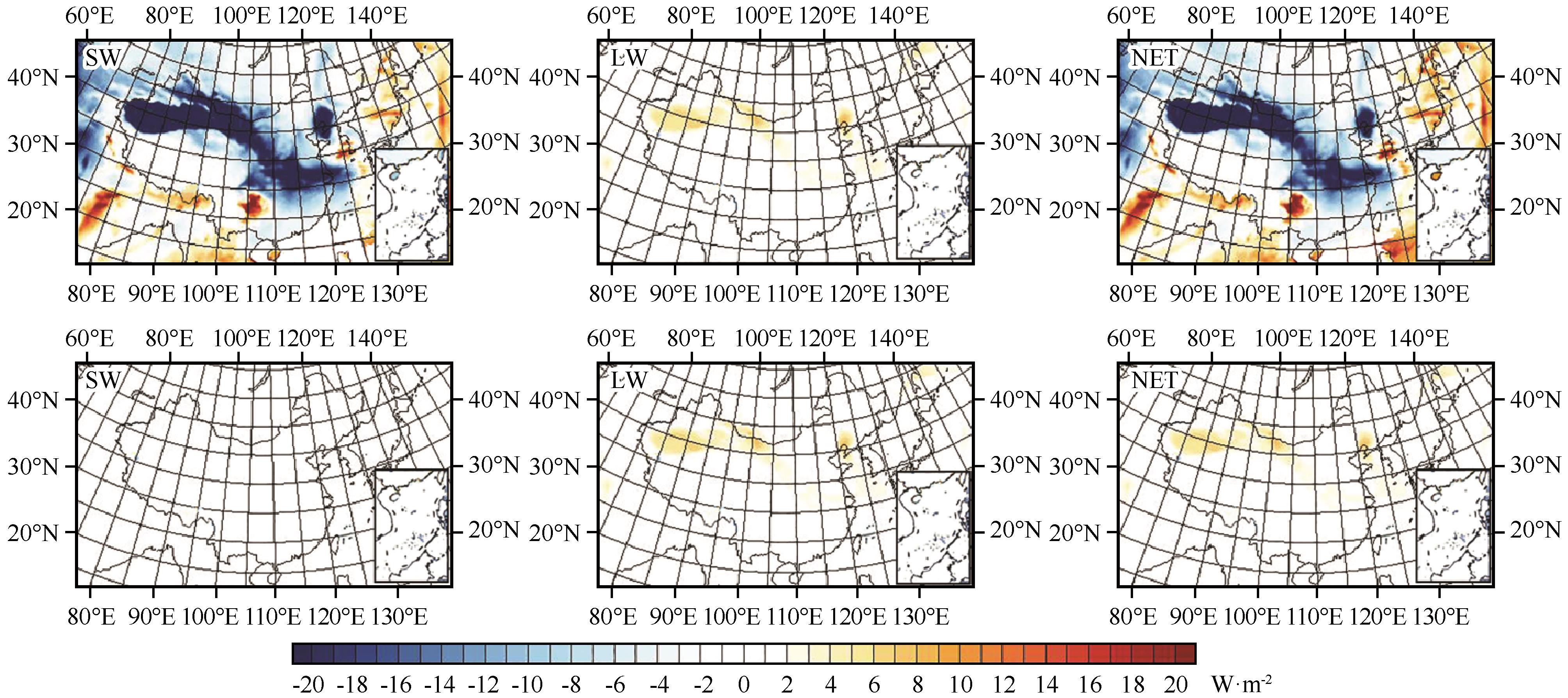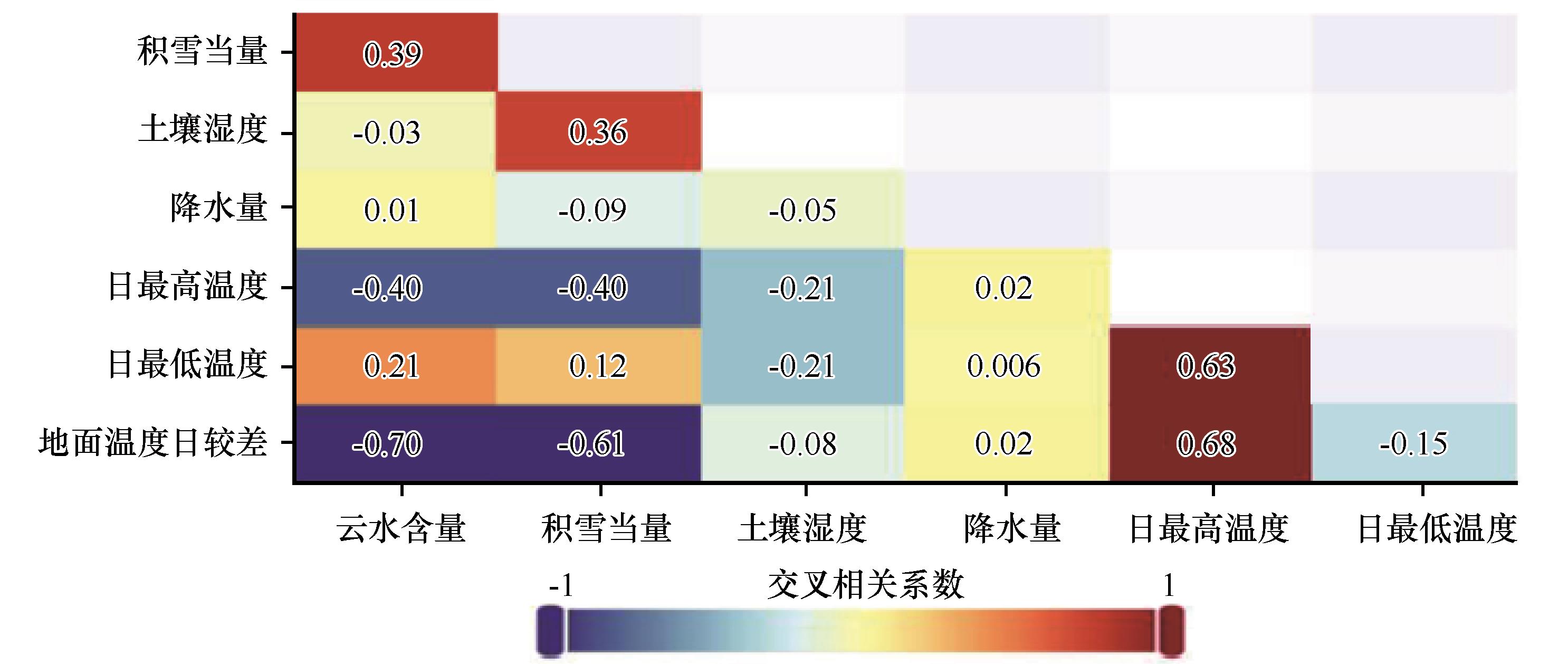
- CN 62-1070/P
- ISSN 1000-694X
- Bimonthly 1981

Journal of Desert Research ›› 2022, Vol. 42 ›› Issue (3): 127-138.DOI: 10.7522/j.issn.1000-694X.2022.00026
Previous Articles Next Articles
Siyu Chen( ), Yawen Guan, Dan Zhao, Gaotong Lou, Yu Chen
), Yawen Guan, Dan Zhao, Gaotong Lou, Yu Chen
Received:2021-11-25
Revised:2022-03-24
Online:2022-05-20
Published:2022-06-01
CLC Number:
Siyu Chen, Yawen Guan, Dan Zhao, Gaotong Lou, Yu Chen. Influence of dust aerosol on land surface diurnal temperature range over East Asia Simulated with the WRF-Chem model[J]. Journal of Desert Research, 2022, 42(3): 127-138.
Add to citation manager EndNote|Ris|BibTeX
URL: http://www.desert.ac.cn/EN/10.7522/j.issn.1000-694X.2022.00026

Fig.6 Change of maximum diurnal temperature, minimum diurnal temperature, diurnal temperature range induced by dust aerosol in four seasons during 2002-2005 simulated by the WRF-Chem model

Fig.7 The influence of dust aerosol on maximum diurnal temperature (A), minimum diurnal temperature (B), diurnal temperature range (C) over East Asia from 2002 to 2005 simulated by the WRF-Chem model

Fig.8 The spatial distribution of shortwave (SW), longwave (LW) and net (NET, SW+LW) radiative forcing in day time (top panel) and at night (bottom), simulated by WRF-Chem in East Asia during 2002-2005

Fig.9 The cross-correlation coefficients between the change of dinurnal temperature range (DTR) and influential factors, listed as follow: liquid water path (LWP), snow cover (SNOW), soil moisture (SW), precipitation (PREP), surface maximum diurnal temperature (Tmax) and surface minimum diurnal temperature, simulated by the WRF-Chem model

Fig.11 The normalization of monthly variations of liquid water path (blue line in A), snow cover (blue line in B), maximum diurnal temperature (orange line), minimum diurnal temperature (green line) and dinurnal temperature range (red line) in the northeast of China (A) and the Tibetan Plateau (B)from 2002 to 2005 simulated by the WRF-Chem model
| 1 | Karl T R, Jones P D, Knight R W,et al.Asymmetric trends of daily maximum and maximum temperature[J].Bulletin of the American Meteorological Society,1993,74(6):1007-1023. |
| 2 | Houghton J, Meira Filho L G, Callander B A,et al.Climate Change 1995:The Science of Climate Change[M].Cambridge,UK:Cambridge University Press,1996:572. |
| 3 | Easterling D R, Horton B, Jones P D,et al.Maximum and minimum temperature trends for the globe[J].Science,1997,277(5324):364-367. |
| 4 | Kukla G, Karl T R.Nighttime warming and the green-house effect[J].Environmental Science & Technology,1993,27:1468-1474. |
| 5 | Dai A, Del Genio A D, Fung I Y.Clouds,precipitation,and temperature range[J].Nature,1997,386:665-666. |
| 6 | Zhou L, Dickinson R E, Tian Y,et al.Evidence for a significant urbanization effect on climate in China[J].Proceedings of the National Academy of Sciences,2004,101(26):9540-9544. |
| 7 | Cao H X, Mitchell J F B, Lavery J R.Simulated diurnal range and variability of surface temperature in a global climate model for present and doubled CO2 climates[J].Climate,1992,5(9):920-943. |
| 8 | Mitchell J F B, Davis R A, Ingram W J,et al.On surface temperature,greenhouse gases,and aerosols:models and observations[J].Journal of Climate,1995,8(10):2364-2386. |
| 9 | Stenchikov G L, Robock A.Diurnal asymmetry of climatic response to increased CO2 and aerosols:forcings and feedbacks[J].Journal of Geophysical Research:Atmospheres,1995,100(D12):26211-26227. |
| 10 | Xue W T, Guo J P, Zhang Y,et al.Declining diurnal temperature range in the North China Plain related to environmental changes[J].Journal of Climate,2019,52(9):6109-6119. |
| 11 | Ramanathan V, Chung C, Kim D,et al.Atmospheric brown clouds:impacts on South Asian climate and hydrological cycle[J].Proceedings of the National Academy of Sciences,2005,102(15):5326-5333. |
| 12 | Sun H, Pan Z T, Liu X D.Numerical simulation of spatial-temporal distribution of dust aerosol and its direct radiative effects on East Asian climate[J].Journal of Geophysical Research:Atmospheres,2012,117(D13):13206-13209. |
| 13 | Guo J, Yin Y.mineral dust impacts on regional precipitation and summer circulation in East Asia using a regional coupled climate system model[J].Journal of Geophysical Research:Atmospheres,2015,120(19):10378-10398. |
| 14 | Li S, Wang T J, Solmon F,et al.Impact of aerosols on regional climate in southern and northern China during strong / weak East Asian summer monsoon years[J].Journal of Geophysical Research:Atmospheres,2016,121(8):4069-4081. |
| 15 | Koren I, Dagan G, Altaratz O.From aerosol-limited to invigoration of warm convective clouds[J].Science,2014,344(6188):1143-1146. |
| 16 | Fan J W, Wang Y, Rosenfeld D,et al.Review of aerosol-cloud interactions:mechanisms,significance,and challenges[J].Journal of the Atmospheric Sciences,2016,73(11):4221-4252. |
| 17 | Price C, Michaelides S, Pashiardis S,et al.Long term changes in diurnal temperature range in Cyprus[J].Atmospheric Research,1999,51(2):85-98. |
| 18 | Huang Y, Dickinson R E, Chameides W L.Impact of aerosol indirect effect on surface temperature over East Asia[J].Proceedings of the National Academy of Sciences,2006,103(12):4371-4376. |
| 19 | Qu W J, Wang J, Zhang X Y,et al.Effect of weakened diurnal evolution of atmospheric boundary layer to air pollution over eastern China associated to aerosol,cloud-ABL feedback[J].Atmospheric Environment,2018,185:168-179. |
| 20 | Qu W J, Zhang X Y, Wang Y Q,et al.Atmospheric visibility variation over global land surface during 1973-2012:influence of meteorological factors and effect of aerosol,cloud on ABL evolution[J].Atmospheric Pollution Research,2020,11(4):730-743. |
| 21 | Tegen I, Fung I.Modeling of mineral dust in the atmosphere:sources,transport,and optical thickness[J].Journal of Geophysical Research:Atmospheres,1994,99(D11):22897-22914. |
| 22 | Huang J P, Fu Q, Su J,et al.Taklimakan dust aerosol radiative heating derived from CALIPSO observations using the Fu-Liou radiation model with CERES constraints[J].Atmospheric Chemistry and Physics,2009,9(12):4011-4021. |
| 23 | 郝丽,杨文,吴统文,等.沙尘气溶胶的光学特性及辐射强迫效应[J].中国沙漠,2010,30(6):1477-1482. |
| 24 | Albrecht B A.Aerosols,cloud microphysics,and fractional cloudiness[J].Science,1989,245(4923):1227-1230. |
| 25 | Kaufman Y J, Fraser R S.The effect of smoke particles on clouds and climate forcing[J].Science,1997,277(5332):1636-1639. |
| 26 | Chen S Y, Zhao C, Qian Y,et al.Regional modeling of dust mass balance and radiative forcing over East Asia using WRF-Chem[J].Aeolian Research,2014,15:15-30. |
| 27 | 贾瑞,刘玉芝,吴楚樵,等.2007-2017年中国沙尘气溶胶的三维分布特征及输送过程[J].中国沙漠,2019,39(6):108-117. |
| 28 | 宿兴涛,李鲲,魏强,等.东亚沙尘光学特性及其对辐射强迫和温度的影响[J].中国沙漠,2016,36(5):1381-1390. |
| 29 | Grell G A, Peckham S E, Schmitz R,et al.Fully coupled “online” chemistry within the WRF model[J].Atmospheric Environment,2005,39(37):6957-6975. |
| 30 | Zhao C, Liu X, Leung L R,et al.The spatial distribution of mineral dust and its shortwave radiative forcing over North Africa:modeling sensitivities to dust emissions and aerosol size treatments[J].Atmospheric Chemistry and Physics,2010,10(18):8821-8838. |
| 31 | Ginoux P, Prospero J M, Torres O,et al.Long-term simulation of global dust distribution with the GOCART model:correlation with North Atlantic Oscillation[J].Environmental Modelling & Software,2004,19(2):113-128. |
| 32 | Mlawer E J, Taubman S J, Brown P D,et al.Radiative transfer for inhomogeneous atmospheres:RRTM,a validated correlated-k model for the longwave[J].Journal of Geophysical Research:Atmospheres,1997,102(D14):16663-16682. |
| 33 | Iacono M J, Mlawer E J, Clough S A,et al.Impact of an improved longwave radiation model,RRTM,on the energy budget and thermodynamic properties of the NCAR community climate model,CCM3[J].Journal of Geophysical Research:Atmospheres,2000,105(D11):14873-14890. |
| 34 | Fast J D, Gustafson W I, Easter R C,et al.Evolution of ozone,particulates,and aerosol direct radiative forcing in the vicinity of Houston using a fully coupled meteorology-chemistry-aerosol model[J].Journal of Geophysical Research:Atmospheres,2006,111(D21):21305. |
| 35 | Barnard J C, Fast J D, Paredes-Miranda G,et al.Evaluation of the WRF-Chem" Aerosol Chemical to Aerosol Optical Properties" Module using data from the MILAGRO campaign[J].Atmospheric Chemistry and Physics,2010,10(15):7325-7340. |
| 36 | Ginoux P, Chin M, Tegen I,et al.Sources and distributions of dust aerosols simulated with the GOCART model[J].Journal of Geophysical Research:Atmospheres,2001,106(D17):20225-20273. |
| 37 | 康丽泰,陈思宇.中国北方一次沙尘天气过程的数值模拟[J].中国沙漠,2017,37(2):321-331. |
| 38 | Hong S Y, Noh Y, Dudhia J.A new vertical diffusion package with an explicit treatment of entrainment processes[J].Monthly Weather Review,2006,134(9):2318-2341. |
| 39 | Chen F, Mitchell K, Schaake J,et al.Modeling of land surface evaporation by four schemes and comparison with FIFE observations[J].Journal of Geophysical Research:Atmospheres,1996,101(D3):7251-7268. |
| 40 | Morrison H, Curry J A, Khvorostyanov V I.A new doublemoment microphysics parameterization for application in cloud and climate models[J].Journal of the Atmospheric Sciences,2005,62(6):1665-1677. |
| 41 | Kain J S, Fritsch J M.A One-Dimensional Entraining/Detraining Plume Model and its application in convective parameterization[J].Journal of the Atmospheric Sciences,1990,47(23):2784-2802. |
| 42 | Smoydzin L, Teller A, Tost H,et al.Impact of mineral dust on cloud formation in a Saharan outflow region[J].Atmospheric Chemistry and Physics,2012,12(23):11383-11393. |
| 43 | Naeger A R.Impact of dust aerosols on precipitation associated with atmospheric rivers using WRF-Chem simulations[J].Results in Physics,2018,10:217-221. |
| 44 | Parkinson C L.Aqua:an earthobserving satellite mission to examine water and other climate variablesL[J].IEEE Transactions on Geoscience and Remote Sensing,2003,41(2):173-183. |
| 45 | Levy R, Remer L, Matto S,et al.Second-generation algorithm for retrieving aerosol properties over I and from MODIS spectra reflectance[J].Journal of Geophysical Research,2007,112(D13):D13211. |
| 46 | Remer L A, Kleidman R G, Levy R C,et al.Global aerosol climatology from the MODIS satellite sensors[J].Journal of Geophysical Research,2008,1113(D14):D14S07. |
| 47 | Hsu N C, Tsay S C, King M D.Deep blue retrievals of Asian aerosol properties during ACE-Asia[J].IEEE Transactions on Geoscience and Remote Sensing,2006,44(11):3180-3199. |
| 48 | Wu G, Zhang Y.Tibetan Plateau forcing and the timing of the monsoon onset over South Asia and the South China Sea[J].Monthly Weather Review,1998,126(4):913-927. |
| 49 | Flanner M G, Zender C S, Randerson J T,et al.Present-day climate forcing and response from black carbon in snow[J].Journal of Geophysical Research: Atmospheres,2007,112(D11):202. |
| 50 | Flanner M G, Zender C S, Hess P G,et al.Springtime warming and reduced snow cover from carbonaceous particles[J].Atmospheric Chemistry and Physics,2009,9(7):2481-2497. |
| [1] | Yi Nana, Jiang Xuegong, Dong Zhulei, Yu Shuiyan, Kang Shengwei. Numerical simulation of a dust process in Inner Mongolia of China [J]. Journal of Desert Research, 2020, 40(3): 115-126. |
| [2] | Hua Cong, Liu Chao, Zhang Bihui. Comparative Analysis of Transport Characteristics of Two Dust Events Affecting Beijing [J]. Journal of Desert Research, 2019, 39(6): 99-107. |
| [3] | Kang Litai, Chen Siyu. Numerical Modeling of a Dust Storm Process in Northern China [J]. JOURNAL OF DESERT RESEARCH, 2017, 37(2): 321-331. |
| [4] | YANG Xing-hua1,2, HE Qing1,2, Ali Mamtimin1,2, HUO Wen1,2, LIU Xin-chun1,2. Observational Study on Near-surface Horizontal Sand-dust Flux of Sandstorms in the Southeastern Fringe of the Taklimakan Desert [J]. JOURNAL OF DESERT RESEARCH, 2013, 33(5): 1299-1304. |
| [5] | HE Zhong;HUANG Chun-chang;ZHOU Jie;PANG Jiang-li;LI Xin-yan;WANG Li-jun;LONG Hao. Holocene Loess and its Deposition Dynamics in the Upper Reaches of the Huaihe River [J]. JOURNAL OF DESERT RESEARCH, 2010, 30(4): 816-823. |
| [6] | LI Jin-chang;DONG Zhi-bao;WANG Xun-ming . Amount of Spring Dustfall and Its Environmental Significance in East Part of Northern China [J]. JOURNAL OF DESERT RESEARCH, 2008, 28(2): 195-201. |
| Viewed | ||||||
|
Full text |
|
|||||
|
Abstract |
|
|||||
©2018Journal of Desert Research
Tel:0931-8267545
Email:caiedit@lzb.ac.cn;desert@lzb.ac.cn
Support:Magtech